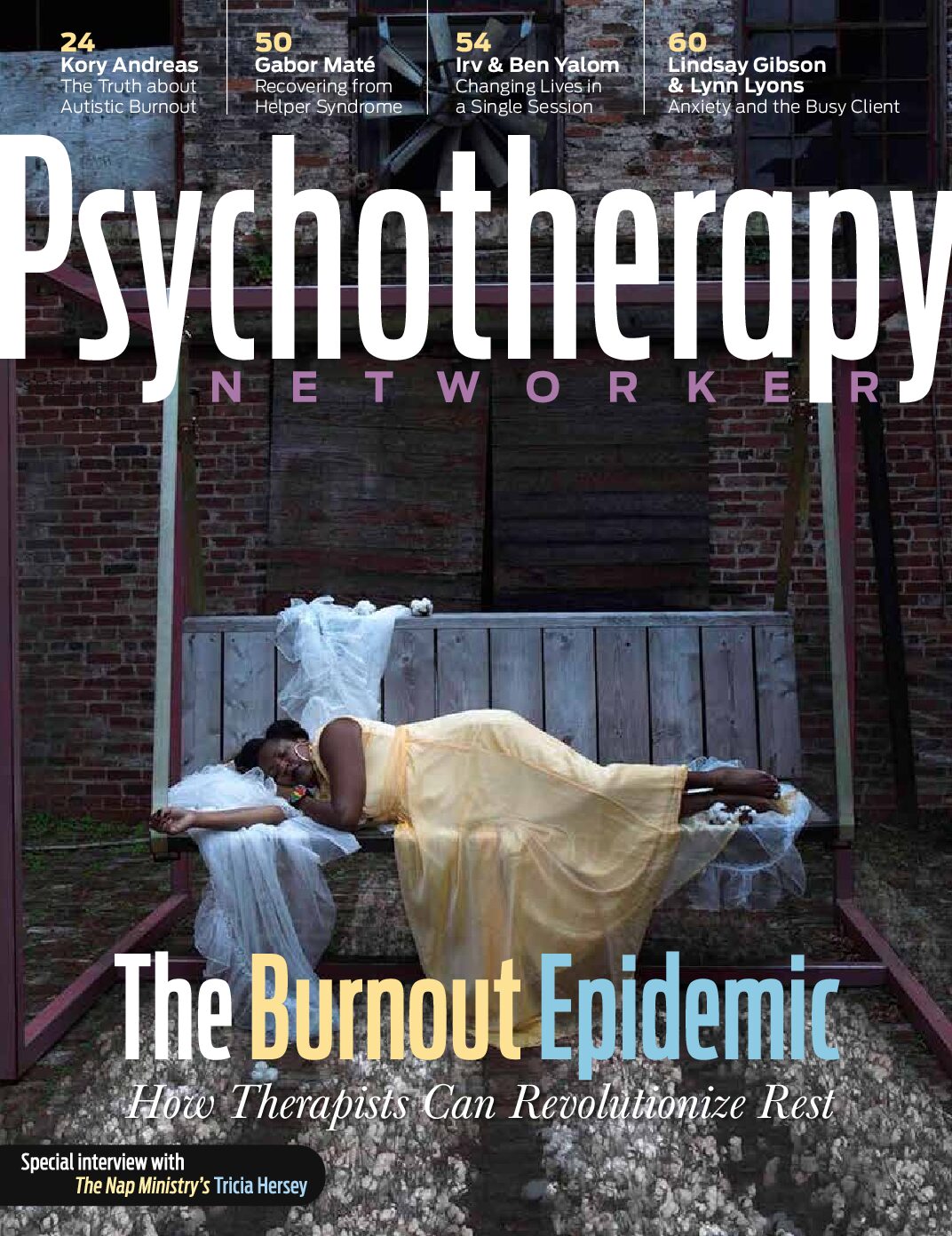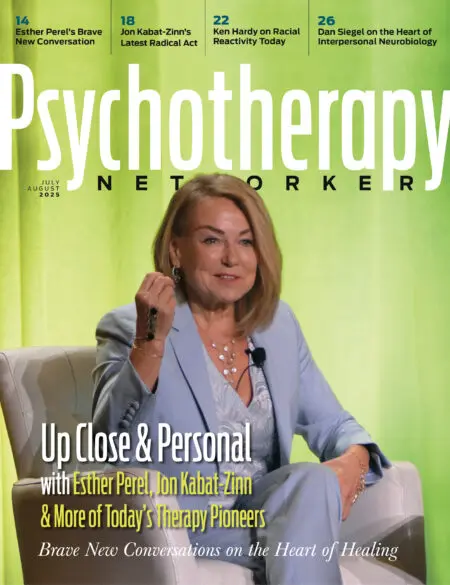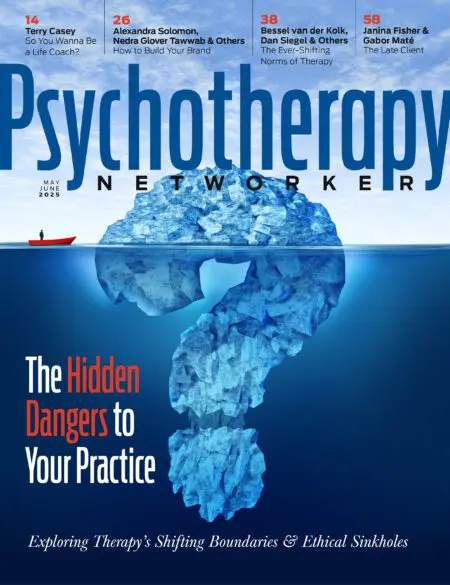Enjoy the audio version of this article—perfect for listening on the go.
How do you approach sessions with a client so busy they only want to see you once a month? Anxiety specialist Lynn Lyons, author of The Anxiety Audit, and psychologist Lindsay Gibson, author of New York Times bestseller Adult Children of Emotionally Immature Parents, share unexpected approaches to working with a time-starved client.
Meet Angelina
Angelina, a 23-year-old woman who’s passionate about public health policy, is in her first year at a state college. She says she chose you as her therapist because she can tell from your books and YouTube videos that you’re really good. She’s been finding it hard to sleep, and her anxiety has gotten so bad that she’s irritable all the time, barely eats, and can’t keep up with her coursework. “I got a late start in college because my dad and mom needed me at home to help with my brothers,” she says. “I really want a career. I want to graduate.”
She shares that she’s significantly older than her two younger brothers, who are seven and twelve. Though she lives on campus, she drives home a few times a week. “As the breadwinner, my mom has to travel a lot for her job,” Angelina says with a shrug. “I try to lighten my dad’s load around the house and get my brothers to their playdates and football practices. Dad makes fun of me a lot for being a nerdy college girl, but I think he only does it because he wants me home. He has panic attacks, and when he gets overwhelmed, he takes it out on everyone, and no one likes that.”
As you wrap up your session, Angelina tells you she’ll only be able to see you once a month. “Is that okay?” She believes seeing you weekly would only add to her anxiety since she has no time to spare. “But something is better than nothing,” she says.
Tweaking, Not Quitting
By Lynn Lyons
When I first meet Angelina and she tells me she believes I’m “really good” based on what she’s read and seen, I ask her to explain. What was it about me and my approach that seemed like a fit?
“I had a call with another therapist that my cousin recommended,” she said. “She sounded nice, but maybe even too nice, if you know what I mean. She wanted me to come in for a few sessions to start an assessment. But she used words that were, I don’t know, therapist-y. No offense, but you sounded different. Like, let’s get to work here. Let’s go. You seem … direct.”
“You don’t have time to waste.”
“Exactly. That’s the problem. I don’t have time. So spending lots of time trying to fix the problem of no time? Can’t do it.”
As Angelina explains her situation—trying to get through college while taking care of her brothers and accommodating her dad’s anxiety and her mom’s work requirements—her strengths are obvious. She’s responsible, ambitious, organized, and strongly connected to her family.
“I know I can do this,” she says. “I’m pretty confident in myself. That’s why this situation pisses me off. I tell myself to suck it up and get it done. But my body is doing all the wrong things. I need to eat and sleep and focus—but I can’t.”
I spend several minutes doing basic psychoeducation about her anxiety symptoms and why they make sense. Even though she’s not in actual danger, her primitive brain is receiving stress messages and responding as it’s designed. “Your amygdala has no idea what college is,” I tell her. “It’s responding as if you’re trying to escape a predator. Digestion and appetite often slow down, as does the prefrontal cortex, making higher level thinking a challenge.” I tell her about worry and rumination, how an anxious mind likes to go over what has already happened and then fret about the future. Anxiety disguises itself as problem solving but rarely offers a solution. She nods along.
“I definitely tend to overthink things,” she says, “but it helps me stay on top on everything I need to do. I have to be obsessive about planning it out. Even at night, no matter how exhausted I am, my mind keeps spinning.”
“Your symptoms make perfect sense to me,” I say. “But I think we need to tweak a few things. Your brain and body are responding as if you’re in an emergency. You’re not, of course, so we need to see how we can shift that a bit.”
Angelina exhales. “I was afraid you were going to tell me I needed to drop out of school or stop helping my brothers,” she says. “I’m not going to do that.”
“Tweak and quit are two very different approaches,” I say.
Angelina doesn’t want to drastically change her approach to managing life. That’s not why she sought me out. She needs and wants to help her family and is clear about her ambition of having a career. I think the biggest mistake I can make is offering suggestions that are in direct conflict with what she wants—and what she feels rightfully capable of achieving.
I’m reminded (as I often am) of an experience I had with a therapist almost 25 years ago. My husband and I were living in a new town with our toddler and newborn. My husband’s job was not going well, and he was struggling, shutting me out. I had no close friends yet, so I made an appointment to talk to a therapist about what I could do to help my husband and our marriage. I made it very clear that I was not trying to decide if I wanted to stay or go. We had two babies, and I loved him deeply. But he was depressed, and I was stuck. “I feel like I’ve tried everything to reach him and nothing is working,” I said.
“Well, you haven’t tried everything,” she said. “You could leave him.”
The session ended politely. But when I got home, I called and left her a message. I wouldn’t be coming back.
I tell Angelina we can play around with some ideas that might help ease the stress—but that I don’t think she can get rid of it completely. “College? Brothers? Dad? It’s a lot. I think some small changes might help tip the scales in your favor. But these are gonna be some busy years.”
“Tweak away,” she says.
We spend the rest of the session problem-solving, making adjustments. We give her worry a name, Stella, and practice responding differently to it. “Hi, Stella, not surprised to see you at all this week. But this is not an emergency. I’m gonna suffer a bit, but I got it.” I explain how externalizing the worry allows her to notice its repetitive patterns and respond differently to its demands and catastrophizing.
She thinks she might be able to hire a friend from high school to pick up the boys when she’s loaded up with coursework. She agrees to pack snacks to graze on during the day, when her appetite or schedule isn’t up for a bigger meal. And less coffee. The four cups a day are not helping. Two? Doable.
I teach her some of my favorite falling asleep hacks, like subtracting 7s from a big number or playing the alphabet game. She was a runner in high school but never exercises anymore. We talk about getting some of her school texts on audio, a service she thinks the college provides, so she can walk/run and listen at the same time.
“Does your dad have any information about how panic works, like the information I gave you? Basic stuff?” I ask.
“Oh god no,” Angelina says. “He has no idea.”
“He can come with you to any session, anytime,” I tell her. “I don’t even need any warning. I’ll fill him in.” In the meantime, I agree to make and send her a short video describing how anxiety works that she can share with him and use to remind herself when needed.
“You’re excellent at saying yes. That’s why you said Yes! to yourself about college and a career. Rather impressive. But I want you to practice saying no a bit more often. Gosh, I’m sorry, that doesn’t work for me. I borrowed that phrase from a friend. I now pass it on to you.”
When our time is up, Angelina asks if she can see me monthly. “Something is better than nothing,” she says.
“Something is better than nothing. I completely agree,” I respond and laugh. “I’m delighted you heard the message loud and clear.”
Helping Anxiety Find Words
Once she took her seat in my office, the first thing Angelina said to me was, “I feel guilty taking up your time. There are lots of other people that need this more than I do.” When I smiled, saying I was sure she had good reasons for being here and I was interested in all of them, she responded, “I just need a few tools to function better and not get so overwhelmed by stuff.”
I could tell Angelina expected to scrape by on the bare minimum for herself. And the way she described her family role echoed what I’ve heard from many of the adult children of emotionally immature parents I’ve worked with. In fact, her parents had her in their late teens, and she told me her mother liked to joke that “they’d all grown up together.” As her parents struggled to forge their careers and build their lives, Angelina had to look out for herself a lot. They called her an “old soul” and often confided in her about their adult problems. When her little brothers were born, she became even more of a parentified child.
In our first session, which included assessing for any issues of self-harm or suicidality, I focused on listening deeply and making an empathic connection with her. I wanted her to know that I took her anxiety and fatigue seriously. After all, most of the people in her life focused on her strengths and overlooked her emotional exhaustion. She told me about how hard she worked to be self-supporting and the scholarships she’d earned.
We seemed to have a good rapport, so I was a little taken aback toward the end of the hour when she proposed once-a-month sessions. If I accepted her monthly plan without discussion, would I be seen as sanctioning her bare minimum approach to herself, too? I didn’t want to scare her off, but I needed her to know that I thought she needed more help than she was allowing herself.
“Angelina,” I said, “your anxiety is partly due to how hard you’re working, but I think it’s also telling you that you’re approaching an important crossroads in life where your choices are going to make a big difference. You’re pursuing your dream, but you’re also trying not to leave your parents behind. I get it, and I also get the impression that your parents are so used to your help that they may not be aware of how much pressure you’re under. I think part of you is trying to decide if you have the right to think about yourself and your own future. I’m sympathetic to your schedule, but at once a month, it would be like starting over each time you come in. Your anxiety symptoms are making your hard job harder and need attention. Would you at least be willing to meet with me again next week so we can get to know each other better and then see where to go from there?
Angelina listened intently and nodded, confirming my hunch that her fear of being needy may have been more of a problem than her schedule. After a couple of weekly sessions, we ultimately agreed on a biweekly schedule, with the option to come in more if needed. This gave her the flexibility she wanted for attending her classes and caring for her brothers.
Although Angelina knew about my work regarding emotionally immature parents, she seemed reluctant to think of her own parents that way. So, I avoided that term when referring to her parents and stuck to exploring how their behavior impacted her emotionally. I saw my role as her adult witness, someone to help her find and connect with her true self instead of worrying about what everyone else thought.
With clients like Angelina whose precocious sense of responsibility makes them overintellectualize and deny their feelings, I like to use experiential, emotionally focused therapies, like Accelerated Experiential Dynamic Psychotherapy (AEDP) and Internalized Family Systems (IFS), along with imaginary-encounter techniques from Gestalt therapy and Emotionally Focused Therapy to make their sessions more emotionally vivid.
After experiencing a particular anxiety-filled night, Angelina came to our session bleary-eyed. “Your anxiety is signaling you again,” I told her, “so let’s help it find words. Close your eyes if that helps you visualize—you can always open them whenever you want. Imagine this anxious part of you as an actual little person. What does it look like? Can you silently interview it and ask it what it’s afraid of? Listen to what it says and then if you like, you can report back to me.”
Angelina initially resisted these imagined encounters because she’d been trained to dismiss her inner world, but after some surprising revelations, she saw the value of experimenting with them and seeing what happened. She started using inner dialogues as a way of dealing with her anxiety. She learned to take it as a cue to start journaling and dig into what she was really worried about, which validated to her how overwhelmed her inner child felt. We also worked with the moralistic part of her that insisted she could only be a good person if she did whatever her parents asked.
AEDP techniques were especially helpful in finding and focusing on her feelings in sessions, as a way of reconnecting her with her core self. As we connected these feelings back to events in her life, Angelina began to see that her emotions made sense, and the more she allowed herself to share whatever popped into her head, whether it made sense or not, the more self-expressive and spontaneous she became.
Gradually, her newfound connection to her feelings led her to experience a healthy self-protectiveness. She started considering her own needs instead of just her parents’, which translated into increased assertiveness and better boundaries on her part, like giving them dates each month when she could help out (while reserving necessary study and recreation time for her own mental health). At first, she felt guilty for not being at their beck and call, and a part of her accused her of being selfish, but this predictable self-criticism lessened as she grew more comfortable making decisions that supported her well-being.
Often, one of the hardest things for adult children of emotionally immature parents to accept is interest and validation from others. They need the mirroring support that they didn’t get with their parents because it helps them become conscious of their true self and its needs, but they often feel overwhelmed by this emotional intimacy and pull back. The AEDP technique of meta-therapeutic processing—a method in which the client is encouraged to talk about a moment of closeness with the therapist—was perfect for this.
“Angelina,” I said, “You’ve really opened up and told me some heartfelt things today. I’m so pleased that you felt safe enough to do that with me. Can we tune in for a moment and talk about what it’s been like for you today to share these things with me?”
“It feels good, but I feel a little silly, like you must get sick of hearing about this.”
“Not at all. In fact, our conversation feels deeper and more alive when you tell me what it’s really been like for you. But tell me more: in what way does it feel good?”
Angelina exhaled deeply: “It’s a relief. I feel like you get it. It’s like taking a boulder off my chest. I feel lighter somehow, like maybe I’m not such a selfish person after all. Like maybe I’m just trying to live too.”
“And what’s that like for you, to feel that?”
“Freer, more lighthearted, not worrying about other people’s opinions. It feels good to be seen.”
These conversations about our interactions gave Angelina the experience of communicating honestly and at a deeper level with another person—something she’d rarely done, since she’d mostly focused on others. Also, our emotional intimacy helped her feel more confident opening up to others outside our sessions and trusting that other people could give her emotional connection and support, too.
Angelina and I ended up working together throughout her time in college, navigating many mini crises with her family while she experimented with healthy independence. Our greatest accomplishment was that she learned to pay attention to how she felt and build a more protective relationship with her own self. She gradually began setting boundaries that allowed her parents to figure out new ways of handling their problems and parental responsibilities.
Her anxiety and guilt steadily lessened as she questioned the legitimacy of pleasing others at her own expense. Mostly, she got to know herself and grew to like who she was inside, even when her parents were disappointed or upset. And she felt like a good person even when she wasn’t fulfilling someone else’s expectation of her.
Lynn Lyons
Lynn Lyons, LICSW, is a speaker, trainer, and practicing clinician specializing in the treatment of anxious families. She’s the coauthor of Anxious Kids, Anxious Parents and is the cohost of the podcast Flusterclux. Her latest book for adults is The Anxiety Audit.
Lindsay Gibson
Lindsay C. Gibson, PsyD, is a clinical psychologist in private practice and author of the New York Times bestseller Adult Children of Emotionally Immature Parents: How to Heal from Distant, Rejecting, or Self-Involved Parents and Recovering from Emotionally Immature Parents: Practical Tools to Establish Boundaries and Reclaim Your Emotional Autonomy. Her books have been translated into 37 languages.














